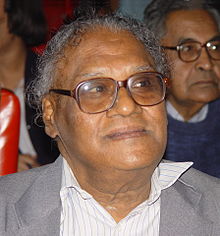C. N. R. Rao
| C.N.R. Rao (ಸಿ.ಎನ್.ಆರ್. ರಾವ್) | |
|---|---|
 |
|
| Born |
30 June 1934 Bangalore, Kingdom of Mysore, British India |
| Residence | India |
| Nationality | Indian |
| Fields | Chemistry |
| Institutions |
Indian Space Research Organisation IIT Kanpur Indian Institute of Science University of Oxford University of Cambridge University of California, Santa Barbara Jawaharlal Nehru Centre for Advanced Scientific Research |
| Alma mater |
Mysore University Banaras Hindu University Purdue University |
| Known for |
Solid-state chemistry Materials science |
| Notable awards |
Shanti Swarup Bhatnagar Prize for Science and Technology (1969) Hughes Medal (2000) India Science Award (2004) Abdus Salam Medal (2008) Dan David Prize (2005) Legion of Honor (2005) Royal Medal (2009) Padma Shri (1974) Padma Vibhushan (1985) Bharat Ratna (2013) Order of the Rising Sun (2015) Order of Friendship (2009) National Order of Scientific Merit (2012) |
|
Website www.jncasr.ac.in |
|
Chintamani Nagesa Ramachandra Rao FRS, also known as C. N. R. Rao (born 30 June 1934), is an Indian chemist who has worked mainly in solid-state and structural chemistry. He currently serves as the Head of the Scientific Advisory Council to the Prime Minister of India. Rao has honorary doctorates from 60 universities from around the world. He has authored around 1,500 research papers and 45 scientific books.
On 16 November 2013, the Government of India announced his selection for Bharat Ratna, the highest civilian award in India, making him the third scientist after C.V. Raman and A. P. J. Abdul Kalam to receive the award. He was conferred the award on 4 February 2014 by President Pranab Mukherjee in a special ceremony in the Durbar Hall of the Rashtrapati Bhavan.
C.N.R. Rao was born in Bangalore to Hanumantha Nagesa Rao and Nagamma Nagesa Rao. He was an only child, and his learned parents made an academic environment. He was well versed in Hindu literature from his mother and in English from his father at an early age. He did not attend elementary school but was home-tutored by his mother, who was particularly skilled in arithmetic and Hindu literature. He entered middle school in 1940, at age six. Although he was the youngest in his class, he used to tutor his classmates in mathematics and English. He passed lower secondary examination (class VII) in first class in 1944. He was ten years old, and his father rewarded him with four annas (twenty-five paisa). He attended Acharya Patashala high school in Basavanagudi, which made a lasting influence on his interest in chemistry. His father enrolled him to a Kannada-medium course to encourage his mother tongue, but at home used English for all conversation. He completed secondary school leaving certificate in first class in 1947. He studied BSc at Central College, Bangalore. Here he developed his communication skills in English and also learnt Sanskrit. He obtained his bachelor's degree from Mysore University in 1951, in first class, and only at the age of seventeen. He initially thought of joining Indian Institute of Science (IISc) for a diploma or a postgraduate degree in chemical engineering, but a teacher persuaded him to attend Banaras Hindu University. He obtained a master's in chemistry from BHU two years later. In 1953 he was granted a scholarship for PhD in IIT Kharagpur. But four foreign universities, MIT, Penn State, Columbia and Purdue also offered him financial support. He chose Purdue. His first research paper was published in the Agra University Journal of Research in 1954. He completed PhD in 1958, only after two years and nine months, at age twenty-four.
...
Wikipedia
